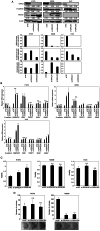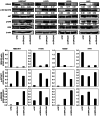Silencing of GRHL2 induces epithelial‑to‑mesenchymal transition in lung cancer cell lines with different effects on proliferation and clonogenic growth
- PMID: 37600329
- PMCID: PMC10433723
- DOI: 10.3892/ol.2023.13977
Silencing of GRHL2 induces epithelial‑to‑mesenchymal transition in lung cancer cell lines with different effects on proliferation and clonogenic growth
Abstract
Grainyhead-like 2 (GRHL2) is a transcription factor that suppresses epithelial-to-mesenchymal transition (EMT). It has been previously shown that GRHL2 can confer both oncogenic and tumor-suppressive roles in human cancers, including breast, pancreatic and colorectal cancers. However, its role in lung cancer remains elusive. In the present study, a meta-analysis of multiple gene expression datasets with clinical data revealed that GRHL2 expression was increased in lung cancer compared with that in the normal tissues. Copy number analysis of GRHL2, performed using datasets of whole exome sequencing involving 151 lung cancer cell lines, revealed frequent amplifications, suggesting that the increased GRHL2 expression may have resulted from gene amplification. A survival meta-analysis of GRHL2 using The Cancer Genome Atlas (TCGA) dataset showed no association of GRHL2 expression with overall survival. GRHL2 expression was found to be associated with EMT status in lung cancer in TCGA dataset and lung cancer cell lines. GRHL2 knockdown induced partial EMT in the hTERT/Cdk4-immortalized normal lung epithelial cell line HBEC4KT without affecting proliferation measured by CCK-8 assays. In addition, GRHL2 silencing caused three lung cancer cell lines, H1975, H2009 and H441, to undergo partial EMT. However, the proliferative effects differed significantly. GRHL2 silencing promoted proliferation but not colony formation in H1975 cells whilst suppressing colony formation without affecting proliferation in H2009 cells, but it did not affect proliferation in H441 cells. These results suggest cell type-dependent effects of GRHL2 knockdown. Downstream, GRHL2 silencing enhanced the phosphorylation of AKT and ERK, assessed by western blotting with phospho-specific antibodies, in HBEC4KT, H1975 and H2009 cell lines but not in the H441 cell line. By contrast, transient GRHL2 overexpression did not affect A549 cell proliferation, which lack detectable endogenous expression of the GRHL2 protein. However, GRHL2 overexpression did suppress E-cadherin expression in A549 cells. These results suggested that GRHL2 does not only function as a tumor suppressor of EMT but can also behave as an oncogene depending on the lung cancer cell-type context.
Keywords: The Cancer Genome Atlas; epithelial-to-mesenchymal transition; human bronchial epithelial cell line.
Copyright: © Kawabe et al.
Conflict of interest statement
JM receives royalties from the NIH and University of Texas Southwestern for distribution of human cell lines. The remaining authors declare that they have no competing interests.
Figures






References
Grants and funding
LinkOut - more resources
Full Text Sources
Miscellaneous
